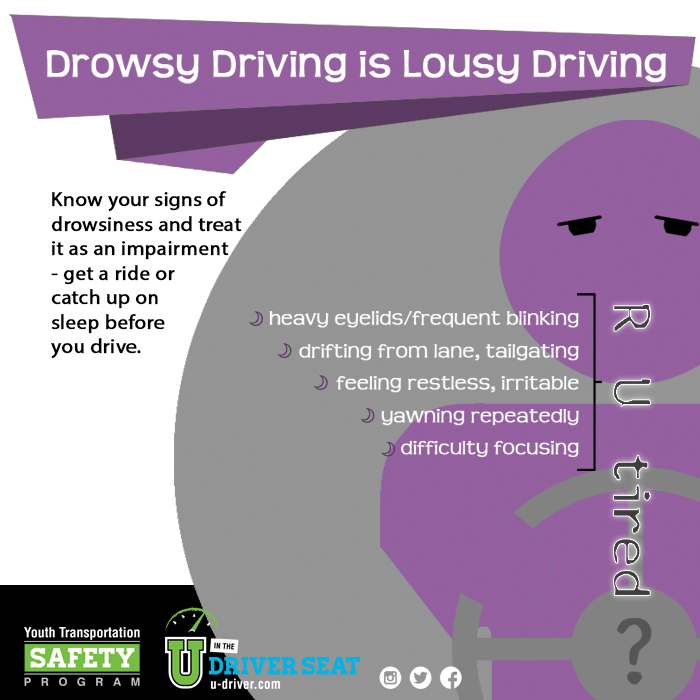Reduced visibility combined with sleep deprivation makes driving at night dangerous
DID YOU KNOW…
- In 2020, 68% of young adult fatal crashes occurred between 6 pm – 6 am (1).
- Rural roadways can be especially dangerous at night due to higher numbers of unlit roadways. In 2020, 42% of fatal traffic crashes occurred on rural roads, and 46% (7,305) of those occurred at night (1).
- A majority of speeding-related fatalities occurred at night in Urban areas (62%) (1).
The impact of sleep habits on driving and other areas:
- Sleepiness and irregular sleep schedules have many unintended consequences, one of which is to negatively impact learning, memory, and performance (2).
- Men are more likely to fall asleep while driving than women (2).
- A study found that individuals who missed 2-3 hours of sleep in a 24–hour period more than quadrupled their risk of a crash compared to drivers getting the recommended seven hours of sleep. This is the same crash risk the National Highway Traffic Safety Administration associates with driving over the legal limit for alcohol (3).
- A survey found that young drivers report being “reluctant to miss out” and have an “always-on lifestyle” that can contribute to drowsy driving as they are getting less than six hours of sleep each night (4).
- 70% of participants surveyed admitted to driving tired
- 50% reported actually falling asleep or nearly falling asleep at the wheel citing:
- A busy schedule: 43%
- Staying up late to do homework: 32%
- Staying up late for social activities: 24%
- Working late hours during the week: 20%
- Being tired or hung over from drinking/partying the night before: 10%
Drowsy vs. Impaired:
- The dangerous combination of sleep loss and alcohol could impair driving performance even in students who are not legally intoxicated (2).
- Drowsy driving and impaired driving have similar effects (5). Both cause:
- Problems with information processing and short-term memory
- Increased moodiness and aggressive behaviors
- Decreased performance, vigilance, and motivation
- Impaired reaction time, judgment, and vision
Identifying Drowsy Driving:
- Here are some signs of being tired and it’s time to pull over (6).
Preventing Drowsy Driving:
- Before you drive, consider whether you are (6):
- Sleep-deprived or fatigued (6 hrs of sleep or less triples your risk)
- Suffering from sleep loss (insomnia) or poor-quality sleep
- Driving long distances without proper rest breaks
- Driving through the night or when you would normally be asleep
- Studying a lot or attending more activities than usual, which may be decreasing your sleep time
- Drinking even small amounts of alcohol
- Driving alone or on a long, rural dark, or boring road
- Lifestyle habits and good planning can help prevent drowsy driving (6):
- Get a good night’s sleep before you hit the road.
- Don’t be too rushed to arrive at your destination. Many drivers try to maximize the holiday weekend by driving at night or without stopping for breaks.
- It’s better to allow the time to drive alert and arrive alive.
- Use the buddy system. A buddy who remains awake for the journey can take a turn behind the wheel and help identify the warning signs of fatigue
- Take a break every 100 miles or 2 hours. Do something to refresh yourself like getting a snack, switching drivers, or going for a jog
- Take a nap. Find a safe place to take a 15-20 minute nap if you think you might fall asleep. Be cautious about excessive drowsiness after waking up.
- Avoid alcohol and medications that may cause drowsiness as a side-effect
- Consume caffeine. The equivalent of two cups of coffee can increase alertness for several hours.
The problem of visibility at night:
- The average person’s field of vision is smaller without the aid of light, and glare from oncoming headlights can further limit the ability to see clearly and avoid hazards.
- High-Intensity lights are becoming more common. These lights are brighter to on-coming traffic and require your eyes to adjust faster.
- It is more difficult to judge other vehicles’ speeds and distances at night.
- Dusk can be a dangerous time to drive because there’s typically a lot of congestion and your eyes are constantly having to adjust to more darkness.
What to do about poor visibility (7):
- Keep distractions to a minimum to keep your eyes and attention on the road.
- Reduce your speed and increase your following distances. Don’t overdrive your headlights. You should be able to stop inside the illuminated area. If you can’t, you are creating a blind crash area in front of your vehicle.
- Keep your headlights and windshield clean. A thin film of debris on your headlights can reduce your visibility significantly.
- Avoid the glare of oncoming vehicles by watching the right edge of the road and using it as a steering guide.
Sources:
- NHTSA FARS Data, 2020
- Hershner and Chervin R.D. Causes and Consequences of Sleepiness Among College Students. Nature and Science of Sleep. 2014. https://www.ncbi.nlm.nih.gov/pmc/articles/PMC4075951/
- AAA: https://newsroom.aaa.com/2016/12/missing-1-2-hours-sleep-doubles-crash-risk/
- Liberty Mutual & SADD:https://www.libertymutualgroup.com/about-lm/news/news-release-archive/articles/new-study-finds-teens-fear-of-missing-out-is-proving-to-be-dangerous
- National Sleep Foundation: https://www.sleepfoundation.org/teens-and-sleep
- DrowsyDriving.org: https://www.thensf.org/tips-for-preventing-drowsy-driving/
- National Safety Council: https://www2.safetyserve.com/articles/driving-at-night/
Updated August 2023
